研究锌在减轻血铅水平对肠道微生物群多样性的毒性中的作用:NHANES 2007-2010。
IF 2.9
3区 医学
Q2 TOXICOLOGY
引用次数: 0
摘要
锌是跨物种许多重要过程的辅助因子。构成肠道微生物群的微生物依赖于这些依赖锌的机制来执行基本功能,为多样化和稳定的微生物环境做出贡献。环境污染物,如铅,已被证明会破坏多样性和稳定性。本研究的目的是确定锌是否可以作为一种有效的调节剂来对抗血铅水平升高(BLL)对肠道微生物群多样性的影响。方法:利用2007-2008年和2009-2010年NHANES数据集进行横断面复杂调查分析,以肠内酯(ENL)作为生物标志物,旨在确定锌摄入量是否作为与BLL相关的微生物组多样性变化的保护因素。采用多元线性回归来评估BLL和锌摄入量之间的相互作用是否可以预测ENL。该模型包括纤维摄入量和BMI作为协变量。结果:BMI和纤维摄入量被确定为协变量。纤维摄入量是锌和ENL水平之间关系的一个混杂变量。铅可降低ENL水平(p= 0.002)。锌与BLL的交互作用极显著(p=0.089)。结论:本研究提示铅对肠道微生物多样性的影响可能取决于锌的状态。这些发现强调了考虑膳食混杂因素(如纤维摄入量)对提高模型准确性和解释的重要性。虽然需要进一步的研究来证实锌的潜在保护作用,但鼓励摄入足够的锌和纤维的公共卫生策略可能在一定程度上有助于支持微生物的恢复能力,并减少铅对肠道微生物群的影响。本文章由计算机程序翻译,如有差异,请以英文原文为准。
Investigating zinc’s role in mitigating blood lead levels’ toxicity on gut microbiota diversity: NHANES 2007–2010
Introduction
Zinc serves as a cofactor for numerous vital processes across species. Microorganisms that make up the gut microbiome rely on these zinc-dependent mechanisms to perform essential functions, contributing to a diverse and stable microbial environment. Environmental contaminants, such as lead, has been shown to disrupt diversity and stability. The purpose of this study was to determine whether zinc serves as an effect modifier against elevated blood lead levels (BLL) on gut microbiota diversity.
Methods
The 2007–2008 and 2009–2010 NHANES datasets were utilized to conduct a cross-sectional complex survey analysis aimed at determining whether zinc intake acts as a protective factor against changes in microbiome diversity associated with BLL, using enterolactone (ENL) as a biomarker. A multiple linear regression was conducted to evaluate whether an interaction between BLL and zinc intake could predict ENL. The model included fiber intake and BMI as covariates.
Results
BMI and fiber intake were identified as covariates. Fiber intake was a confounding variable in the relationship between zinc and ENL levels. Lead was found to decrease ENL levels (p = 0.002). The interaction between zinc and BLL was marginally significant (p = 0.089).
Conclusion
This study suggests that lead’s impact on gut microbial diversity may depend on zinc status. These findings emphasize the importance of accounting for dietary confounders, such as fiber intake, to improve model accuracy and interpretation. While additional research is needed to confirm zinc’s potential protective role, public health strategies encouraging adequate zinc and fiber intake may in part help support microbial resilience and reduce lead’s effects on the gut microbiota.
求助全文
通过发布文献求助,成功后即可免费获取论文全文。
去求助
来源期刊

Toxicology letters
医学-毒理学
CiteScore
7.10
自引率
2.90%
发文量
897
审稿时长
33 days
期刊介绍:
An international journal for the rapid publication of novel reports on a range of aspects of toxicology, especially mechanisms of toxicity.
 求助内容:
求助内容: 应助结果提醒方式:
应助结果提醒方式:


